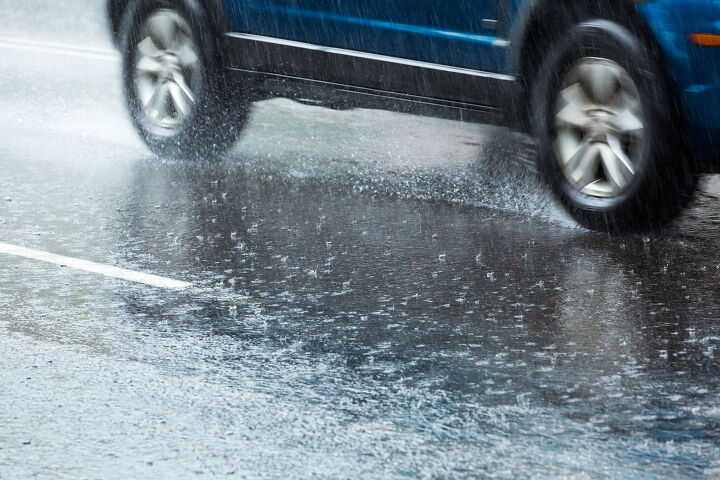How Three-Season Tires Perform in Diverse Weather Conditions

Advances in the field of tire and rubber technology (yes, that’s a thing; we promise) have permitted manufacturers to make huge strides in the ability of these things to grip surfaces of all types. In the past, there was a push to sell all-season tires which performed at kinda-sorta acceptable levels in a variety of conditions but didn’t truly excel in any particular environment.
These days, tire companies seem to be laser focused on providing consumers with rubber which is uniquely suited for the job. This helps explain why some brands and retailers have ditched the “all-season” moniker in favor of the “three-season” title, permitting them to highlight the strengths of these tires while directing buyers to a dedicated set of winter tires for when the snow flies.
Generally, tread patterns on three-season tires are smooth and straight, traits which are ideal for repelling water whilst driving in the rain and gripping the road when temperatures have us all sweatin’ to the oldies. In warm to hot conditions, the compounds baked into the rubber of these tires do a great job of sticking to tarmac road surfaces – not to the extent of performance tires found on supercars of course but certainly better than a tire which is designed specifically for winter use.
Promoted Product: RoadX MX440
With winter being only one of the four seasons, there is a definite need for tires that are designed for the other three seasons, and the RoadX RXMotion MX440 can handle the diverse driving conditions you can encounter during the “rest of the year.”
It is a true 3-season tire designed for both dry and wet conditions and to give you improved handling and exceptional ride comfort. The RXMotion MX 440 variable-pitch tread pattern has four wide circumferential grooves to move water away quickly and efficiently from your contact patch for excellent traction in wet conditions.
The MX440 uses a special 3-season rubber compound that wears long and reduces road noise, while still giving you excellent grip on wet and dry roads. It can handle whatever the road and the weather may bring, making it perfect for 3-season driving. RoadX backs the RXMotion MX440 with a 60,000-mile/60-month tread life warranty (100,000km/60-month in Canada. See website for additional warranty information in your region.
Pros in the tire industry do say three-season tires tend to have a harder rubber compound than some other styles of tire. This leads to numerous benefits, including long tread life and a quiet driving experience in addition to good traction on wet and dry roads during mild temperatures. However, that same tread which presents well in balmy climes can lose the plot when the mercury dips below 7C/45F, sacrificing performance in measures of braking distance and cornering grip.
That’s why it is important to remember that, even if one lives in an area with mild winter conditions, modern tires are all about temperature – not outright snow and ice. If weather where you live regularly stays below 7C/45F during certain parts of the year, three-season tires aren’t a great choice to run 12 months of the year thanks to their relatively stiff rubber compounds and a tread pattern which can easily get clogged with snow and slush. Trusted third-party testing showed a new three-season tire stopped about 8.5 feet shorter than a partially worn winter tire – that’s the difference between a near-miss and a call to yer insurance company.
These same traits which make three-season tires not-so awesome in winter conditions permit them to shine in more temperate environments where the thermometer routinely stays above 7C/45F. Sweeping chutes in the tread pattern are great for evacuating water and preventing hydroplaning, while continuous ribs or bands patterns in that tread contribute to tire rigidity which improve handling on dry pavement and ward off premature wear. Some of these qualities also lend themselves well to low rolling resistance, meaning increased fuel efficiency compared to other types of tires.
With rubber technology having grown by leaps and bounds, the emergence of “all-weather” tires is a notable development of which shoppers should be aware. Most options in this segment have earned that tractive right to bear the stamp of a three-peak mountain snowflake – a mark once reserved for only the gnarliest of winter tires. This is not to say the threshold for achieving this designation has been lowered (in fact, the bar has actually trended higher in recent years because of sizing) but rather that tire tech has advanced to the point it is possible for a manufacturer to make a tire which meets the 3PMS mark whilst still being suitable for year-round use.
We’ll have a more in-depth explainer on this subject in a different post later this year when readers are searching for winter tires and we can grab some of that sweet Google SEO traffic offer timely advice. However, for the purposes of this article talking about three-season tires, know this style of rubber is generally shod with finer tread patterns which – while great for fair weather – tends to perform at a different level in snow and slush or clear sub-zero temps when compared to true winter tire or an all-weather tire. In short, running three-season tires in the warm months means budgeting for a different set of hoops geared for cold climate use in order ensure maximum year-round safety.
In the meantime, drive safely – and watch out for the guy or gal next to you who isn’t nearly as well-informed about tires as our readers.
[Images: RoadX Tires]
Become a TTAC insider. Get the latest news, features, TTAC takes, and everything else that gets to the truth about cars first by subscribing to our newsletter.

Matthew buys, sells, fixes, & races cars. As a human index of auto & auction knowledge, he is fond of making money and offering loud opinions.
More by Matthew Guy
Latest Car Reviews
Read moreLatest Product Reviews
Read moreRecent Comments
- Funky D Back in our day, it would have been an old-school carbureted car with mechanical everything so maintenance would be easy and said teen would learn something along the way.Nowadays, I would get a reliable 4-cylinder car. They certainly don't need a whole lot of horsepower (and in the early 80s, when I was that teenager, there wasn't much HP available!), and unfortunately, other than basic maintenance like oil changes, filters, and possibly brakes.
- IH_Fever Coming soon to a high school parking lot near you, with a flat black painted hood, huge wing, and a hole in the muffler...
- 3-On-The-Tree Motorcycles can be dangerous but there ways to minimize the risk. While in Army flight school the commanding Major General from the U.S Army safety center briefed all the pilots on all the bike fatalities in the Army that year and 99% of them were caused from riders drinking and riding in addition to reckless driving. Don’t drink and slow down reduces that risk by over 99%. You can apply that advice to a lot of things in life. And yes I ride, since 1998. 2002 Hayabusa, 2005 Suzuki Vstrom, 2007 Kawasaki KLR650, 1977 Suzuki GT750 and 1980 Suzuki GS1000. No accidents currently.
- Jackie morgan I have a 1983 S-10 Durango. Bought new 1 owner. Still in original condition. Garage kept no rust dealer undercoat. V6 automatic, longbed. Loaded with extras. Transmission needs work. Body in great condition.
- Wjtinfwb We had a few 500/Taurus cars in the company fleet. If a long trip was on the docket, I always tried to reserve one as they were great road cars with a ton of room front and back and gigantic trunk. Decent highway manners and a comfortable ride. The high seating position came from the basic design of the Taurus, it shared structure and underpinnings with the Gen 1 Volvo XC90 and S80, I believe it had pretty good crash test results as a side benefit of the Volvo design. The most remarkable part of this generation Taurus however was it's incredibly boring and down market interior. Dull as dishwater.



































Comments
Join the conversation